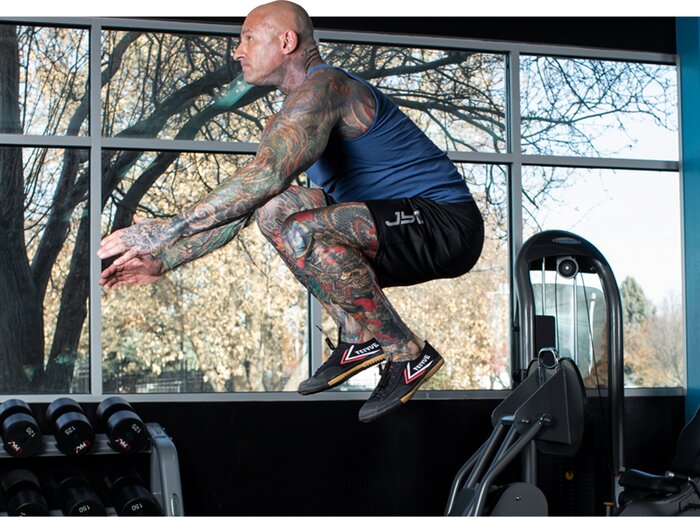If your goal is to get bigger and stronger, don't forget a third critical component of your training: power. So many people go heavy in the gym and take sets to failure—which is great for building strength and size, respectively—but totally ignore dedicated training for power and explosiveness.
Here's why that's a mistake: The more power you possess, the stronger you'll be when it comes time to put some real weight on the bar. Power and strength go hand in hand. Strength is defined as the amount of weight you can lift; power refers to how fast you can move a given weight. If you're not able to move a bar with some speed off your chest on the bench press or out of the hole on squats or deadlifts, your ceiling for getting stronger will be fairly low.
Developing muscular power will also help you build muscle. The stronger and more powerful you are for a one-rep max (1RM), the stronger you'll be when training in more hypertrophy-friendly rep ranges, like 8-10 or 12-15. If you can go heavier in these higher rep ranges, you'll build more muscle.
How do you train for more power? Just about any major gym exercise can be turned into a power-building move, so your exercise selection is endless. For some specific ideas, read my "Secrets of Strength" here at Bodybuilding.com.
Once you decide on your exercises, make sure you're using the right weight, sets and reps, and timing to ensure you're getting the most out of your power training. Below, I break down these three areas.
Weight Selection: Keep It Light
Unlike training for size and strength, it's best to use a relatively light weight, typically somewhere around 50 percent of your 1RM on a given lift. Developing muscular power requires you to move a weight as fast and explosively as possible. If you load the bar with 90-100 percent of your 1RM, your rep speed will slow dramatically; in this case, you're training for pure strength, not power. Strength and power may go hand in hand, but the two are trained very differently in the gym.

If you're doing jump squats, using body weight only will suffice for most people. Stronger individuals can do barbell or dumbbell jump squats, but even then, the weight should be extremely light. For chest, bodyweight plyometric push-ups are a great power move—no added resistance needed.

Sets and Reps: Go for Low Volume
Usually, when you choose a light weight, you're going to do high reps with it. If you're training to build muscle, that would be the case. But when you're training specifically for power development, you want to the keep the rep counts low—no more than 10 per set. You may be tempted to do more because the weight feels so light, but you must fight that temptation.
When training for power, you do not want to approach muscle failure. The reason is the same as that for keeping the weight light: to keep your rep speed as fast as possible. As you approach muscular failure, the speed at which you're moving the weight will naturally decrease. If you're not moving the weight as fast as you possibly can, you're not training for power.
You also want to keep your total sets relatively low on power moves. Again, it comes down to muscle fatigue. The higher the volume, the more the muscles will fatigue, and the more fatigued they are, the slower your rep speed.
As a rule of thumb, I prescribe doing power exercises for 2-3 sets of anywhere from 3-10 reps. I also advise generous rest periods of at least 1 minute—and up to 2-3 minutes—between sets. This will give your muscles time to recover so they're not fatigued going into subsequent power sets.

Timing: Train for Power When You're Fresh
When programming power moves in a training program, you have two possible scenarios. You can include power training in a workout that also features strength and/or hypertrophy training or do a power-training-only workout.
In the first scenario, you always want to do your power training before the heavier strength exercises and hypertrophy work that fatigue the muscles. Your power moves should be done when your muscles are at their freshest. For example, if you're doing a leg workout consisting of squats, lunges, and jump squats, do the jump squats first. Likewise, if you want to do plyometric push-ups as part of a chest workout, do them before moves like the bench press, dumbbell press, or high-rep flyes and cross-overs.
If your entire workout is power training, these rules don't really apply because every exercise will be a power move. That said, be mindful of total volume per muscle group. If you're doing a full-body power workout, limit the routine to only one or two exercises per major muscle group. Frankly, one power move per muscle group is sufficient, particularly if you're training up to 10 muscle groups the way I do (chest, back, shoulders, legs, biceps, triceps, abs, forearms, traps, calves).
For more training tips and workouts, as well as information on nutrition and supplementation, visit JimStoppani.com.
